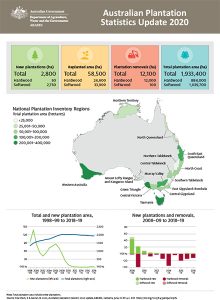The area under hardwood plantations across Australia has continued to drop according to Australian Bureau of Agricultural and Resource Economics and Sciences estimates in its Australian plantation statistics 2020 update. Source: Timberbiz
Australia’s total commercial plantation area in 2018–19 was 1,933,400 hectares, 9300 hectares (0.5%) less than the area recorded in 2017‒18, and 86,800 hectares (4.3%) less than the area recorded in 2008–09.
The total area of softwood plantations increased marginally in 2018–19 to 1,039,700 hectares and accounted for 54% of total commercial plantation area. The total area of hardwood plantations decreased to 884,000 hectares in 2018–19 and accounted for 46% of total commercial plantation area.
In 2018‒19 Victoria continued to have the largest total area of commercial plantations in Australia (418,500 hectares), followed by New South Wales (393,200 hectares) and Western Australia (359,900 hectares).
ABARES estimates that a total area of 130,200 hectares (6.7%) of Australia’s commercial plantations was in the fire extent of the 2019–20 bushfires in southern and eastern Australia.
 Most of the plantation area in the fire extent was in New South Wales (71%) and South Australia (13%). The effects of the bushfires on Australia’s commercial plantation estate are not reflected in the 2018–19 data in this report but will be accounted for in the 2019–20 comprehensive spatial stocktake report.
Most of the plantation area in the fire extent was in New South Wales (71%) and South Australia (13%). The effects of the bushfires on Australia’s commercial plantation estate are not reflected in the 2018–19 data in this report but will be accounted for in the 2019–20 comprehensive spatial stocktake report.
A total of 2800 hectares of new plantations were established in 2018–19, comprising 2750 hectares of softwood plantations and 50 hectares of hardwood plantations. Around 92% of new plantations established in 2018–19 were publicly owned and 8% were privately owned.
In 2018–19 a total of 58,500 hectares of plantations were replanted, comprising 33,900 hectares of replanted softwood plantations (58%) and 24,600 hectares of replanted or coppiced hardwood plantations (42%).
A total of 12,100 hectares of Australia’s plantation estate was converted to another land use in 2018–19, comprising 12,000 hectares of hardwood plantations (99%) and 100 hectares of softwood plantations (1%). Most converted plantations were in South Australia (52%), followed by Western Australia (29%) and Victoria (19%).
In 2018–19 a total of 1,459,900 hectares of plantations were privately owned, representing 76% of the total plantation estate. Public plantations accounted for 21% (402,600 hectares) of the total plantation estate and jointly owned (joint partnerships between state forest agencies and leasehold and freehold landowners) plantations represented 3.7% (71,000 hectares).
The ownership structure of plantations remained relatively unchanged between 2017‒18 and 2018‒19. In 2018–19 institutional investors owned 49% of the total plantation area, governments owned 21%, farm foresters and other private growers owned 21%, managed investment schemes owned 5%, and timber industry companies owned 4%. In 2018–19 the hardwood plantation estate was dominated by Tasmanian blue gum (50%) and shining gum (26%), both of which are managed primarily for pulp log production. The softwood plantation estate was dominated by radiata pine (75%) and southern pines (15%), both of which are managed for sawlog production.








